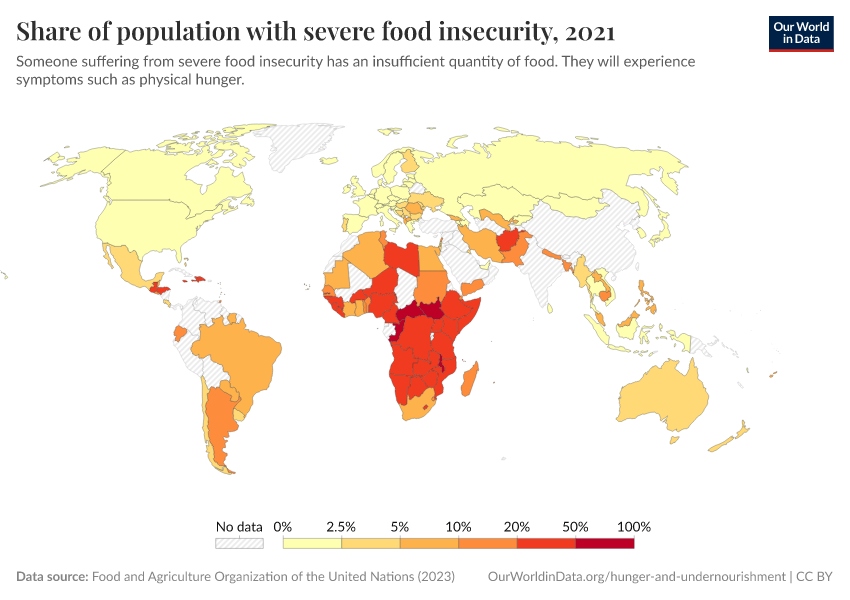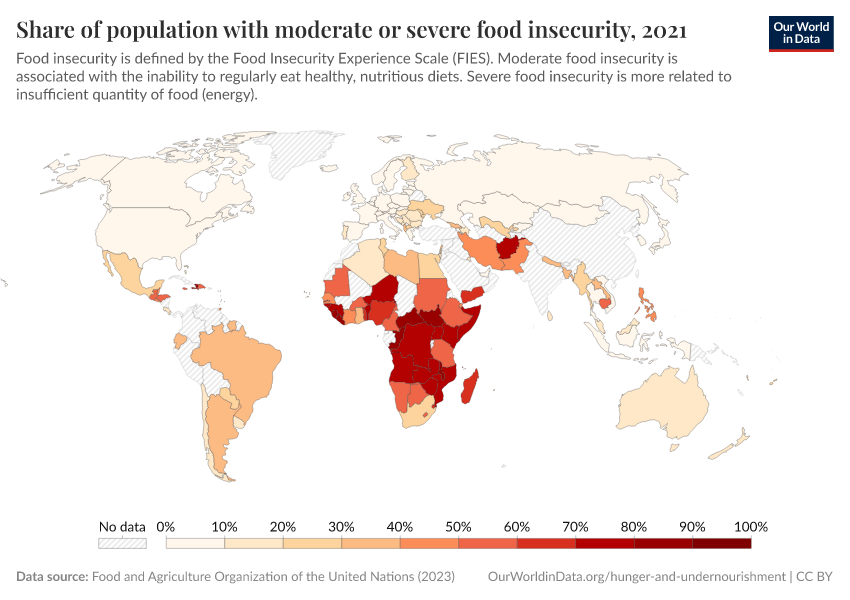How is food insecurity measured?
Billions of people suffer from food insecurity. What does it mean to be food insecure?
Food insecurity is defined by the Food and Agriculture Organization (FAO) of the United Nations as the “situation when people lack secure access to sufficient amounts of safe and nutritious food for normal growth and development and an active and healthy life.”
The chart below shows the share of the population that is ‘severely food insecure'. Let’s look at what this means, and how this is measured.

What is food insecurity and how is it measured?
Food insecurity is one of the major causes of poor nutrition.
Food insecurity can be caused by several factors: food might be physically unavailable in a particular country or region; it can be unaffordable even if it is available to buy; or there might be an unequal distribution of food between household members.
Food insecurity is measured by the FAO using its Food Insecurity Experience Scale (FIES) global reference scale.
Food insecurity can be based on having enough food (the quantity) or having inadequate quality and diversity of food. Someone might get enough food to meet their energy requirements, but they might rely on only a few basic foods (such as cereals) and have a diet with very little diversity.
The FIES measures the share of the population that has experienced food insecurity at moderate or severe levels during the period of measurement. Data is collected at the household level using a food security questionnaire. This survey asks households about a number of conditions that someone with food insecurity would typically experience.
It’s based on eight questions (the full list is given at the end of this article), such as:
“During the last 12 months, was there a time when you (or any other adult in the household) were worried you would not have enough food to eat because of a lack of money or other resources?”.
And:
“Was there a time when you (or any other adult in the household) had to skip a meal because there was not enough money or other resources to get food?”
These eight questions increase in severity: the first question is about worrying that you might not have enough food to eat at some point over the year. This evolves to actually eating less than is sufficient, then finally to going a whole day or more without any food.
The scale shows the definitions of food insecurity, ranging from mild to severe.
Moderate food insecurity is generally associated with the inability to regularly eat healthy, nutritious diets. It’s an important indicator of poor dietary quality and a high risk of micronutrient deficiencies.
The share of people that are either moderately or severely food insecure is shown in the chart.

Severe food insecurity is more strongly related to insufficient quantity of food (energy) and therefore strongly related to undernourishment or hunger.
In principle, the share of people that are severely food insecure should be similar to the share of the people that are defined as undernourished. Both metrics are used to estimate how many do not get enough food (in terms of energy) to eat. They just try to measure this in different ways. Food insecurity is based on household survey responses, which are more qualitative measure. Undernourishment is estimated based on actual food availability across the population; its a more quantitative measure.
In the chart below we see the correlation between these two metrics: on the y-axis we have the prevalence of severe food insecurity, and on the x-axis we have the prevalence of undernourishment. If these estimates were identical, they’d lie along the diagonal gray line.

We see that these metrics are very strongly correlated, although not perfectly. This may be for several reasons.
Peoples’ subjective experience of food availability might vary from their actual availability.
Undernourishment measurements are based on average calorie availability across the year. People might suffer from severe food insecurity on very short time scales i.e. they might have experienced a week of very little food, but have enough for the rest of the year. That means estimates of food insecurity from surveys would give a higher prevalence than undernourishment metrics.
Eight questions used to measure food insecurity
As explained above, the UN FAO uses a survey of eight questions to evaluate whether someone is food insecure or not. These eight questions are:
- During the last 12 months, was there a time when you (or any other adult in the household) were worried you would not have enough food to eat because of a lack of money or other resources?
- Still thinking about the last 12 months, was there a time when you (or any other adult in the household) were unable to eat healthy and nutritious food because of a lack of money or other resources?
- And was there a time when you (or any other adult in the household) ate only a few kinds of foods because of a lack of money or other resources?
- Was there a time when you (or any other adult in the household) had to skip a meal because there was not enough money or other resources to get food?
- Still thinking about the last 12 months, was there a time when you (or any other adult in the household) ate less than you thought you should because of a lack of money or other resources?
- And was there a time when your household ran out of food because of a lack of money or other resources?
- Was there a time when you (or any other adult in the household) were hungry but did not eat because there was not enough money or other resources for food?
- Finally, was there a time when you (or any other adult in the household) went without eating for a whole day because of a lack of money or other resources?
Explore more data on food insecurity and hunger:
Cite this work
Our articles and data visualizations rely on work from many different people and organizations. When citing this article, please also cite the underlying data sources. This article can be cited as:
Hannah Ritchie (2023) - “How is food insecurity measured?” Published online at OurWorldinData.org. Retrieved from: 'https://archive.ourworldindata.org/20251209-133038/food-insecurity.html' [Online Resource] (archived on December 9, 2025).BibTeX citation
@article{owid-food-insecurity,
author = {Hannah Ritchie},
title = {How is food insecurity measured?},
journal = {Our World in Data},
year = {2023},
note = {https://archive.ourworldindata.org/20251209-133038/food-insecurity.html}
}Reuse this work freely
All visualizations, data, and code produced by Our World in Data are completely open access under the Creative Commons BY license. You have the permission to use, distribute, and reproduce these in any medium, provided the source and authors are credited.
The data produced by third parties and made available by Our World in Data is subject to the license terms from the original third-party authors. We will always indicate the original source of the data in our documentation, so you should always check the license of any such third-party data before use and redistribution.
All of our charts can be embedded in any site.